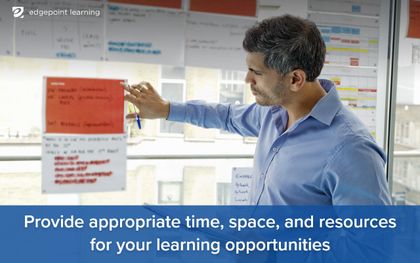How To Build A More Effective Employee Training Plan
Corey Bleich
🍿 5 min. read
If 2020 taught us anything, it’s that we can never predict what’s around the corner.
From millions of people working from home to depleted supply chains, 2020 challenged businesses of all sizes to move quickly and adapt. An employee training plan that built a flexible, well-trained workforce was a key way that businesses kept up with the fast pace of these changes and challenges.
Here’s how to build a more effective employee training plan as we move into the future.
How do you create an employee training plan?
Creating an employee training plan is fairly straightforward on the surface. Essentially, there are seven steps:
- Identify your employees’ training needs
- Find what current materials you can leverage
- Match the method to the subject
- Match the method to the employee
- Come up with a realistic plan
- Develop your training plan
- Measure, reassess, and improve over time
Let's look at the nuances of each of these steps in more detail. Since building a full program is such a large undertaking, we've linked to many of our previous posts below so you can learn more about each topic.
Identify your employees' training needs
A training needs analysis helps you identify the training needs of employees and set goals for your entire employee training program. This is the "what" of the particular training program you're building.
For example, you'll consider if the training is for:
- New employees
- New managers
- Overall training for staff on updated systems
- Diversity training
- Change management
How you approach each employee training program will be slightly different, so it’s good to have a focus before you begin.
Find what current materials you can leverage
Many companies have a closet full of old in-person training manuals and a thumb drive with PowerPoints from 2001. Which of these can you leverage as an employee training plan template to work from?
If the information isn't outdated, you may be able to easily use the information you’ve already developed to create a new delivery model that works better for your employees today.
This is likely also the step where you'll begin to consider your budget. How much resources you have to work with will affect your method of delivery and other factors.
Match the method to the subject
Designing a new delivery method of material is crucial. Your millennial and Gen Z employees are digital natives who pick up information quickly when it’s delivered in a way that meets their needs. Sometimes, though, a hands-on approach is best.
You'll select from (or mix) ten types of employee trainings, each of which can be tailored to specific skill development. These generally include:
- Instructor-led training: Good for developing team-based problem-solving skills (and can also be modified to virtual instructor-led options)
- eLearning: Asynchronous options so employees can learn anywhere, anytime from their computer or mobile device
- Simulation employee training: Gives employees an opportunity to learn complex skills without worry of failure
- Hands-on training: Learning on the job to develop hard or technical skills
- Coaching or mentoring: These personal relationships help employees feel supported and are especially useful for long-term employee development
- Lectures: For delivering information quickly on a simple topic to a large audience
- Group discussion and activities: Great for team-building and developing soft skills
- Role-playing: Develops empathy, especially in public-facing roles
- Management-specific activities: Builds leadership internally so managers can learn how to better support their teams
- Case studies or other required reading: Learning from real-life cases to see cause and effect
Which type of training you choose depends entirely on your subject and training goals.
Match the method to the employee
Educational research shows us that people learn in different ways.
When creating an employee training plan, design multiple access points in the training so that individual employees can use the training methods we discussed above that works best for them.
Come up with a realistic plan
Employees should be able to complete training or development easily in addition to their other duties.
To do this, make sure all managers (and the C-suite) is on board with a realistic schedule that takes into account all other job responsibilities. Build time in an employee's day where they can focus on training, rather than pushing it to their off-hours or squeezing it in when possible.
6. Develop your training materials
Developing your training materials means sitting down with your goals, your identified training needs, and all materials you currently have to actually design how you will deliver the training. You'll further map out any budgetary considerations for training and how it will affect the end result.
This step can take longer than you realize.
Developing quality trainings does not happen overnight.
7. Measure, reassess, and improve over time
A crucial step of any employee training program is ongoing assessment. While many companies start by looking for increased productivity or other company-based measures, employee engagement is a better place to start. Employees who are engaged and interested are more likely to produce the kind of results you are looking for.
Why?
Engaged employees are invested in the success of their workplace. They look for ways to stay with your company, motivated to reach their own professional goals as they learn. When this happens, it follows that your employee training program will produce positive results.
But the opposite is also true. If employees are not engaged, and the training is not meeting their needs, they are less likely to invest themselves in completing it. When this happens, it’s time to take a step back to reassess and make improvements. Sometimes the training goals don’t match what’s actually needed. Sometimes the method of delivery is inefficient. Whatever the reason, taking time to assess how it’s going can identify your growing edges.
Avoid these pitfalls
Based on our years of experience helping companies develop many different learning experiences, some of the most common pitfalls companies experience when developing a new employee training program include the following.
Putting the entire burden of training on the employee
Your employees are already working hard. Expecting them to squeeze training into their schedule without providing some relief or structured time for it dooms them to fail from the start.
Avoid this by providing appropriate time, space, and resources for your learning opportunities.

Developing a rigid unchanging plan
Sometimes even the best training plans are interrupted by circumstances. As COVID-19 taught us, the companies that are best able to weather these extraordinary times are agile and adaptable.
Remain flexible in your training, as company or employee needs can change rapidly.
Not following-up with employees
Remember the last step of implementing an employee training plan, assessment? If you skip this part and don’t follow up with employees, how will you know how they’re doing? How will you know if your training is successful?
Your employees are a great resource. They want to use their time well, too. Schedule regular check-ins for feedback and modifications as needed.
Build your employee training plan
Companies looking to grow and adapt will, at some point, need to train their employees. Getting ahead of what you need before you need it means your company is prepared for the future.
Building an employee training plan can be complicated, but EdgePoint Learning is here to help.
Whether you need a customized program built just for you or are looking to take advantage of our library of microlearning resources, get in touch to see what we can do for you.
